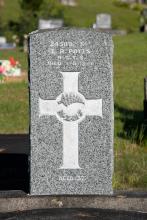"TRUCK STRUCK BY TRAIN BODIES OF VICTIMS INCINERATED (P.A.) WELLINGTON, August 1. Two soldiers were killed instantly and their bodies incinerated when the Army truck in which they were travelling collided with a passenger train at the railway crossing leading to Trentham Camp to-night. They were: Sergeant Edward Roy Potts, whose next-of-kin live at Cranley Street, Dargaville. Driver Thomas George Calnon, whose next-of-kin live at 45 Belvedere Road, Wellington. Both were members of the Temporary Staff, attached to Supply and Transport. The truck was the second of two returning to camp with supplies of slack coal. The first of the trucks crossed the railway line safely. Its driver did not hear the crash of the collision as he drove on toward the camp gates. The second truck, a six-wheeler loaded with about three tons of coal, was caught by the engine. The force of the impact, according to onlookers, was terrific. The truck was carried across the cattle stop in the direction of Trentham station, bursting into flames before it came to rest about 45 yards from the centre of the level crossing, It’s cab in which the men were riding was crushed almost beyond recognition. Coal was strewn over the crossing, and along the side of the railway track. As it was carried on the front of the engine the truck struck first the fencing beside the cattle stop, which was j shattered. Next the truck hit a telephone pole, snapping it off. This brought down the power and signal lines of the railway system, and the signals were put out of order. The seat, in the cab of this type of truck is just above the petrol tank, and in this case, according to information obtained at the camp, there were about 24 gallons in the tank, which burst at the time of the impact. Petrol was sprayed in all directions, catching fire immediately. It was impossible for onlookers to do anything to rescue the bodies of the men. Fire engines from Trentham camp and the Upper Hutt fire station were quickly on the scene, and as soon as the flames had been subdued it was seen that the bodies of the men had been incinerated." [Ashburton Guardian, Volume 66, Issue 249, 2 August 1946, Page 5]


